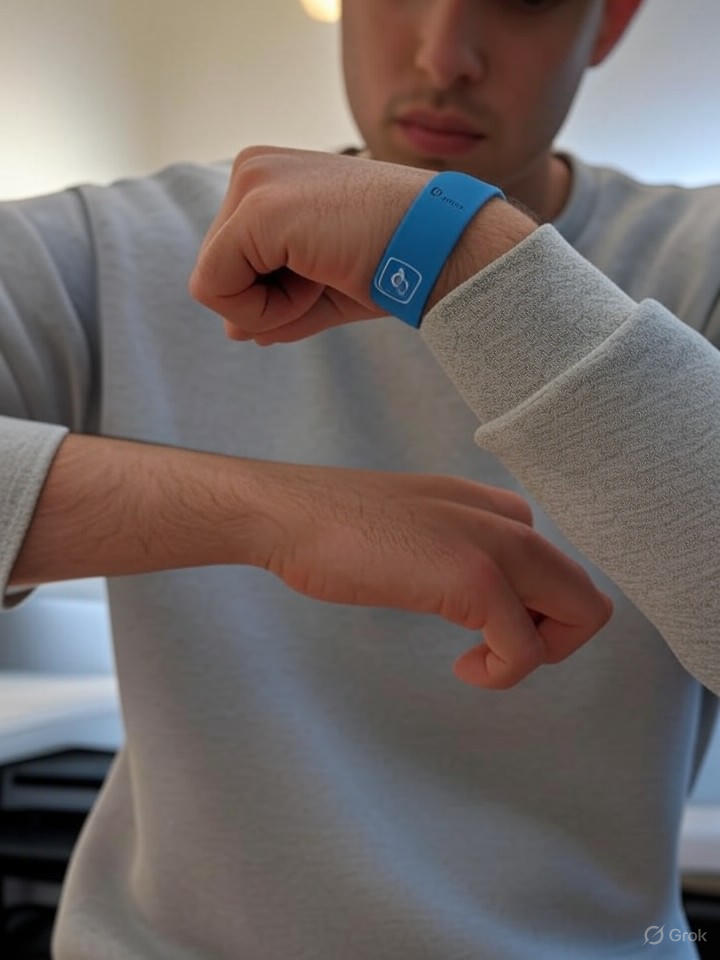In the rapidly evolving realm of augmented reality, Meta Platforms Inc. is pushing boundaries with a novel input method that could redefine how users interact with AR glasses. Drawing from advanced neural interface research, the company has developed a wristband that interprets subtle finger movements—or even the mere intention to move—into precise commands. This technology, rooted in electromyography (EMG), promises to eliminate clunky controllers or voice inputs, allowing seamless control of digital overlays in the real world.
At its core, the system uses sensors on a wrist-worn device to detect electrical signals from muscles and nerves. These signals are translated in real-time to actions like scrolling, selecting, or gesturing within an AR environment. Meta’s researchers, as detailed in a paper published in the scientific journal Nature, have demonstrated how this EMG band can discern minute intentions, such as the thought of pinching fingers together, without requiring visible motion. This breakthrough builds on years of work at Meta’s Reality Labs, aiming to make AR interactions as intuitive as thinking.
The Neural Edge in Wearable Tech
Industry insiders note that this isn’t just about convenience; it’s a strategic move to integrate AI-driven interfaces into everyday wearables. By combining the wristband with upcoming AR glasses like Meta’s Orion project, users could navigate virtual menus or manipulate holograms discreetly in public settings. According to reporting from Android Central, the technology “reads your mind via a wristband that knows what your hands are up to,” highlighting its potential to bridge human intent and machine response.
Comparisons to existing smart glasses, such as Ray-Ban Meta models, reveal stark advancements. While current devices rely on touch panels or voice commands, this EMG approach minimizes latency and enhances privacy by avoiding audible inputs. Sources like Archyde describe it as enabling control “with just a thought,” underscoring the shift toward bio-based interfaces that could outpace competitors like Xiaomi’s AI glasses, which focus more on battery life than neural precision.
Challenges in Signal Processing
Yet, perfecting this tech involves overcoming significant hurdles in signal accuracy and user calibration. EMG readings can be noisy, influenced by factors like sweat or arm position, requiring sophisticated AI algorithms to filter and interpret data reliably. Meta’s paper in Nature outlines machine learning models that achieve over 90% accuracy in gesture detection, but scaling this for diverse users—across ages, fitness levels, and neurological variations—remains a key challenge.
Moreover, ethical considerations loom large. Privacy advocates worry about the implications of devices that tap into neural signals, potentially collecting sensitive biometric data. Meta has emphasized user consent and data encryption, but as Mashable India reports, this “experimental wearable tech reads muscle activity to let users scroll, type, or move cursors with minimal or no visible motion,” raising questions about unintended data insights into users’ physical states or emotions.
Market Implications for AR Adoption
For industry players, this innovation could accelerate AR’s mainstream adoption, positioning Meta against rivals like Apple and Google in the race for next-gen wearables. Analysts predict that integrating EMG with AR glasses might reduce barriers to entry, making devices more accessible for professional applications in fields like surgery or remote collaboration, where hands-free control is paramount.
Looking ahead, Meta’s leaked prototypes, including a smartwatch-EMG hybrid discussed in earlier Android Central coverage, suggest a broader ecosystem. If successful, this could transform AR from a novelty to an indispensable tool, much like smartphones evolved from basic communicators. As the technology matures, expect collaborations with eyewear brands to bring these mind-reading capabilities to consumers, potentially reshaping human-computer interaction for decades to come.




 WebProNews is an iEntry Publication
WebProNews is an iEntry Publication